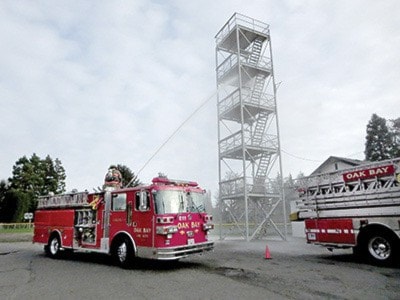Doors wide open to the community, cool fall air fills the fire hall bay doors and firefighters don ear protection for the first tasks of the morning.
Air brakes and alarms sound from all directions as the day’s shift starts the 8 a.m. truck check.
The brake check routine is required. Everything else gets a check so it’s in place, so if they get a call, everything is as they expect for response, Jon Popham explains.
He heads to a drying rack to pull, lay out and hand-roll the half-dozen lengths of hose hanging there.
The Oak Bay fire team do a four-crew blitz, pressure testing the more than 200 length of hose once a year, he explains. “You get the longer life span off of it by taking care of it.”
Meanwhile, firefighter mechanic Jason Ahokas – who actually belongs to another shift – works on Engine 1, removing tires, an unusual sight for a Thursday morning at the Monterey Avenue fire hall. He heads to public works to fix the problem, resolved by the end of the day.
A team meeting outlines work for the day, then week, and upcoming issues.
The CRD is working on water, but shouldn’t actually affect flow. A hydrant near Henderson is still out of commission, reflected on the maps of Oak Bay with a yellow sticker.
Firefighter John Ballantyne shows me my backward-facing seat for the ride-along, and a hand-me-down turnout coat to keep me warm while waiting in the truck during the lone call of the day, a first responder medical call.
A one-call day isn’t unusual, but also not the norm. Firefighter Danny Adam recalls a windstorm that saw more than a dozen calls in the first few hours of a shift.
In a focal shift, I head out with Deputy Chief Darren Hughes and Fire Safety Officer Rob Kivell for an inspection at Oak Bay Recreation Centre. It’s a critical hub, Kivell says, with a condensed population in the centre and the Shannon Oaks residence across the street.
His inspection is “to make sure all the fire equipment is current and serviced.”
But it’s twofold, Hughes says. “Every time we’re on inspections, we’re training.”
A little lunch and training starts the afternoon. For my benefit we cover two topics: CPR and overdose treatment.
A good refresher leaves me happier with my life-saving skills (CPR refresher courses are offered routinely through Recreation Oak Bay and the fire department). Then we squeeze a tomato full of faux naloxone, packaged to look and act like naloxone, injected to block the effects of opioids including extreme drowsiness, slowed breathing or loss of consciousness. Naloxone is used to treat a narcotic overdose in an emergency situation and Oak Bay firefighters are trained to use it – and they have.
After a hands-on drill to down a fully enflamed third-storey fire and understand the process of command, firefighters Ballantyne and Greg Swan share tactics and skills learned at a recent Nozzle First course.
Then, finally, a coffee break.
As darkness falls another call comes in – a report of a missing manhole cover. After hours, public works phones are re-routed to the fire department. A large hole in the sidewalk is of concern, so the truck heads out to discover the broken metal round settled in on top of a water meter. A handful of pylons and a round trip to the works yard later, and all is well.
